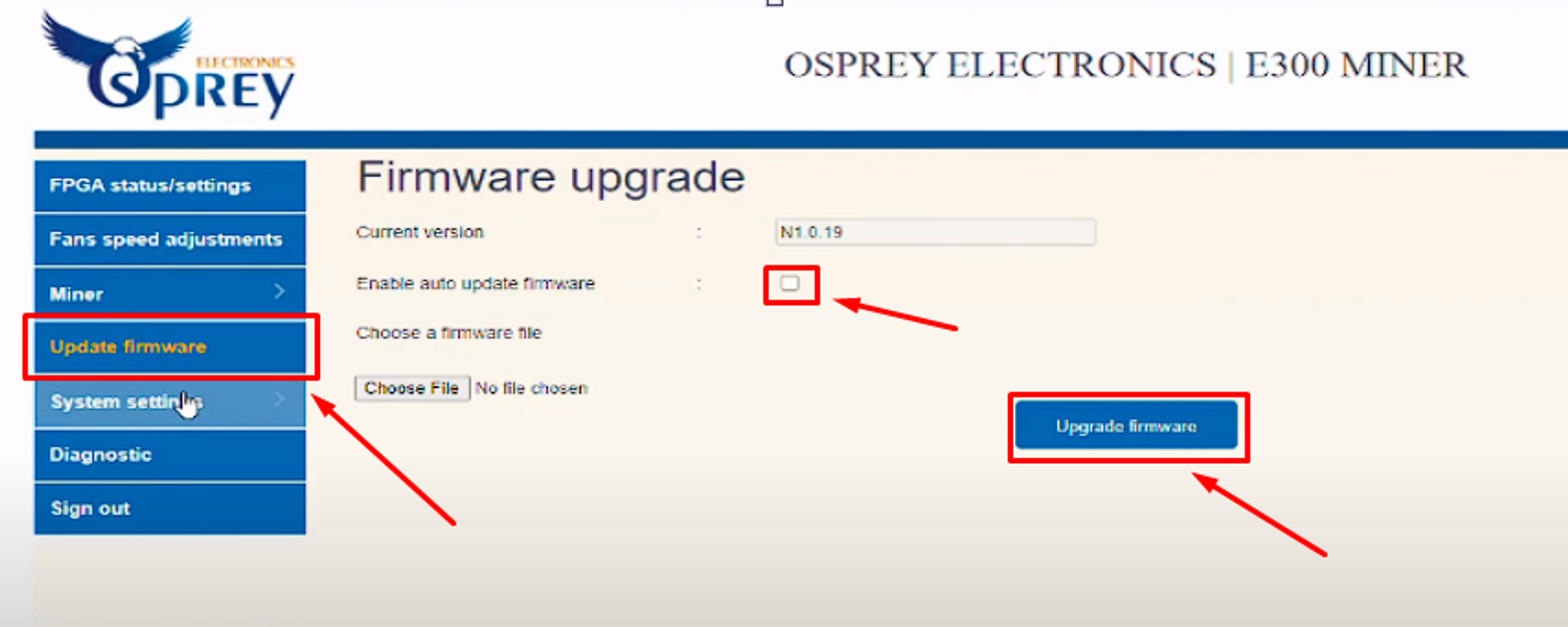FPGA Osprey E100, E300
13/07/2023
FPGA (field-programmable gate array) is one of the most interesting and complex devices for mining. Unlike ASICs, FPGA can be flexibly configured for different mining algorithms. The power of FPGA will be lower than that of ASIC, but higher than a graphics card.
Osprey is producing energy efficient programmable FPGA units for KASPA, SEDRA, KCN mining. Kryptex PPS+ Pool is the best pool that has tested and supports new FPGA models Osprey E300-VU35P, E300-VU33P, E100-VU35P.
Important note! The main difference between FPGA and ASICs is that they can be customised for different algorithms. One FPGA model can be used for mining several different algorithms. Most often, ASICs are limited to only one algorithm. Developers of FPGA miners charge an extra fee for using the product (up to 10%).
Osprey FPGA — Specifications and Size

| Model | Algorithm | Coin | Hashrate | Consumption | Dimensions (cm) | Weight |
|---|---|---|---|---|---|---|
| E300-VU35P | kHeavyHash | KASPA, SEDRA | KAS, SDR — 16,7 Gh/s | 700 Watt (±10%) | 33 x 12,7 x 15,2 | 5 kg |
| E300-VU33P | kHeavyHash | KASPA, SEDRA | KAS, SDR — 9,9 Gh/s | 500 Watt (±10%) | 33 x 12,7 x 15,2 | 5 kg |
| E100-VU35P | kHeavyHash | KASPA, SEDRA | KAS, SDR — 4,6 Gh/s | 175 Watt (±10%) | 33 x 12,7 x 15,2 | 3 kg |
FPGA Osprey E300, E100 Hashrate
Osprey FPGA hashrate can vary depending on the overclock, algorithm, and model.
Osprey E100-VU35P can make 4,6 Gh/s on kHeavyHash (KASPA) algorithm.
E300-VU35P is the most powerful FPGA for mining from Osprey. E300-VU35P can make 17,6 Gh/s,.
What to Mine on Osprey FPGA?
FPGA Osprey E300-VU35P, E300-VU33P, E100-VU35P currently support mining on kHeavyHash (KASPA), kHeavyHash (SEDRA), SHA3d (KCN) algorithms.
Developers announce plans to add support for Autolykos (ERG) and SHA512256d (RXD) mining algorithms in the near future.
Osprey E300, E100 Profitability
Currently, the profitability of Osprey FPGA varies from $0,9/day to $2,8/day, depending on the model, and excluding electricity costs.
We recommend to check the actual profitability in our mining calculator, where you can also calculate the profitability including your electricity costs.
| Model | Coin | Hashrate | Consumption | Profit w/o El. Price |
|---|---|---|---|---|
| E300-VU35P | KASPA, SEDRA | KAS, SDR — 16,7 Gh/s | 700 Watt (±10%) | ~2,8$ / day |
| E300-VU33P | KASPA, SEDRA | KAS, SDR — 9,9 Gh/s | 500 Watt (±10%) | ~1,4$ / day |
| E100-VU35P | KASPA, SEDRA | KAS, SDR — 4,6 Gh/s | 175 Watt (±10%) | ~0,9$ / day |
Check the profitability of Osprey FPGA on the mining calculator.
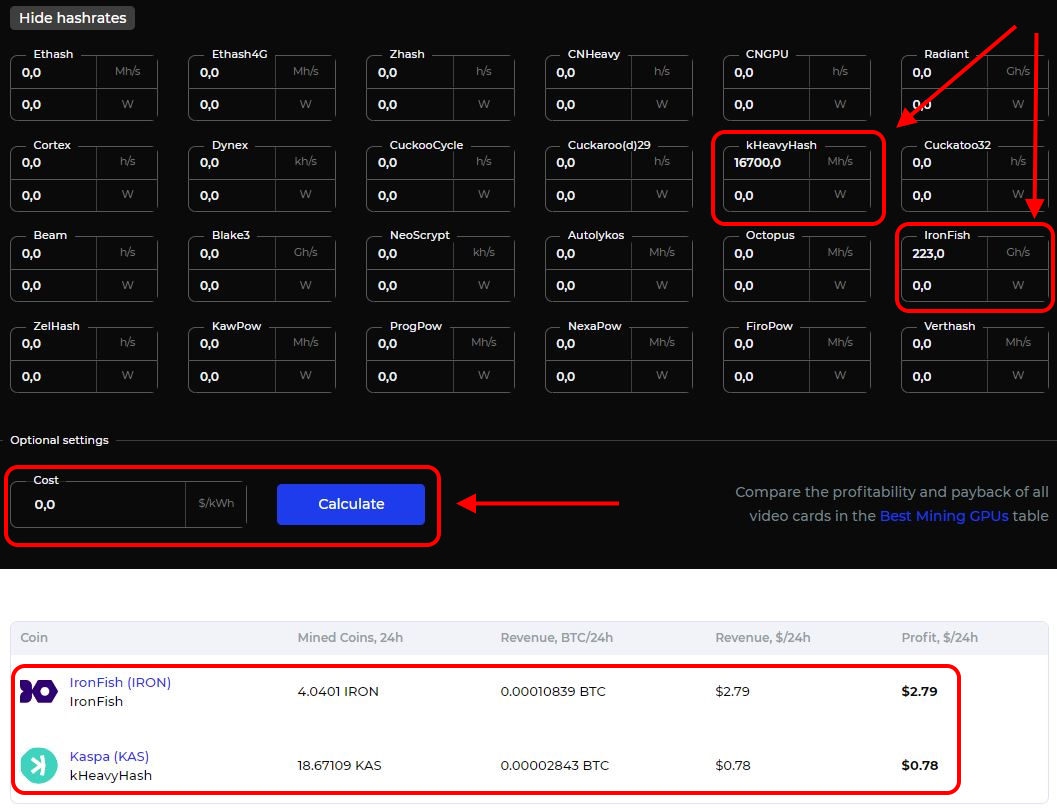
Osprey FPGA Settings
Go to “Miner” tab to setup your FPGA.
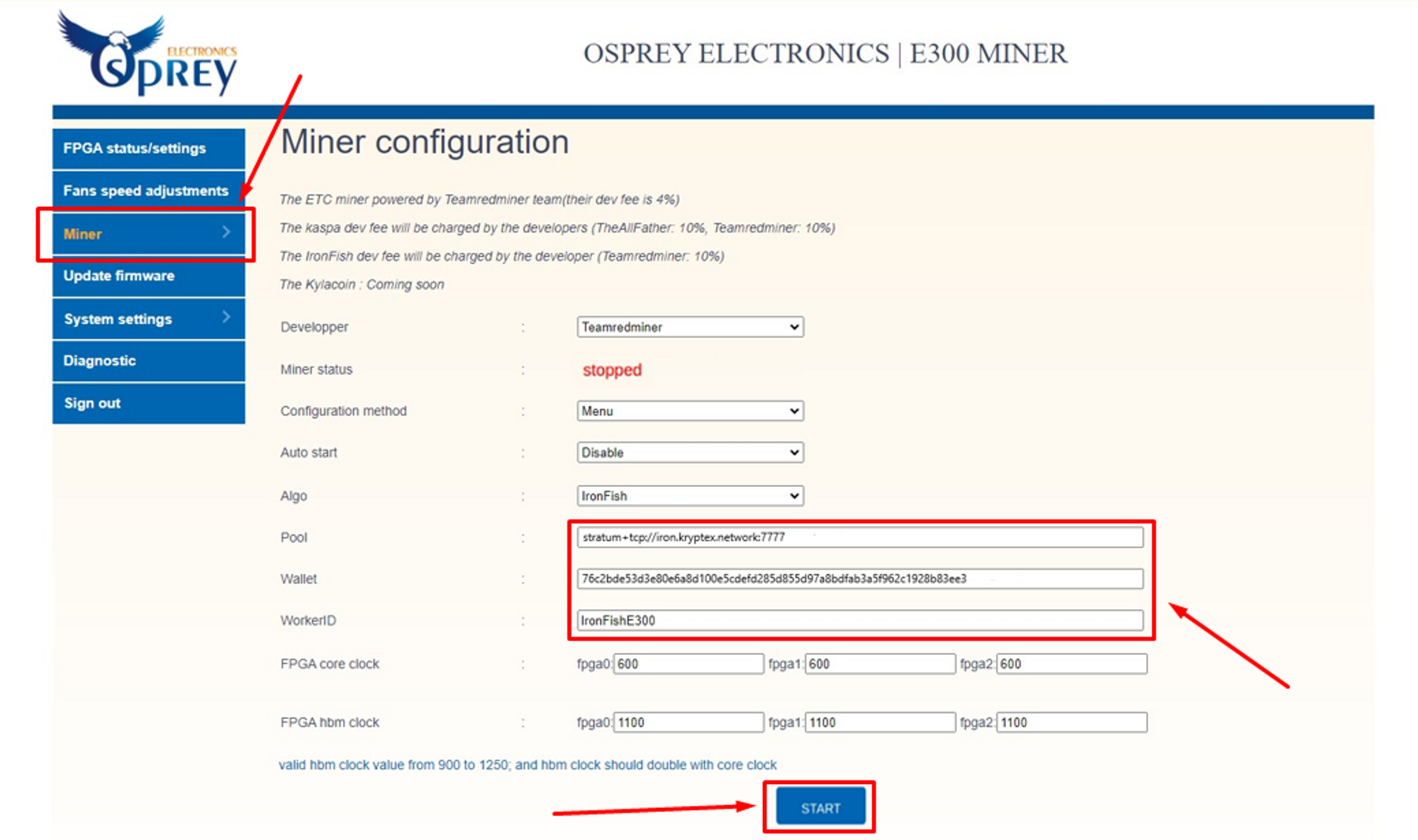
| Coin | Pool | Wallet | WorkerID |
|---|---|---|---|
| KASPA | kas.kryptex.network:7011 or stratum+tcp://kas.kryptex.network:7011 |
KASPA_WALLET_ADDRESS |
WORKER_NAME |
| SEDRA | sdr.kryptex.network:7018 or stratum+tcp://sdr.kryptex.network:7018 |
SEDRA_WALLET_ADDRESS |
WORKER_NAME |
- Wallet is the wallet address filled in the format:
76c2bde53d3e3e80e6a8d100e5cdefd285d855d97a8bdfab3a5f962c1928b83ee3. - WorkerID is the name of your FPGA, specified in Latin letters:
E300.
Click "Start" to save your settings and start mining.
Monitor your FPGA work on the “Miner” → “Miner Logs” page. Here you will see your hashrate, statistics of accepted shares and all related information.
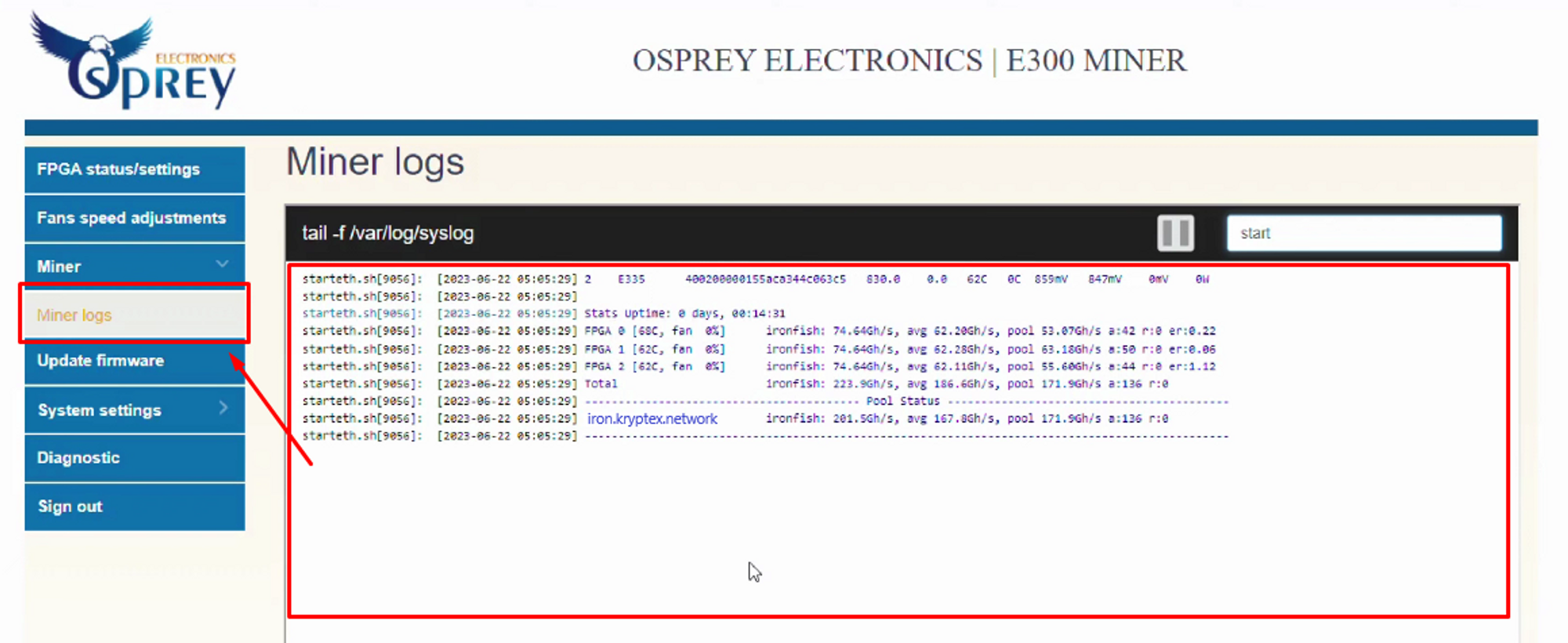
You can find the detailed instructions for a specific Osprey FPGA model on the developer's Github — https://github.com/PachiraMining/E300_development/blob/main/E300_Manual_Guide_V1.0.2.pdf
Overclocking Osprey E100, E300
Overclocking the FPGA can make it overheat and cause unstable operation. Overclocking above the recommended values is dangerous and can damage the device! Overclocking should be done wisely, carefully study all aspects and consult with advanced users!
The FPGA architecture allows you to flexibly adjust the core and memory frequency for different algorithms.
To overclock the Osprey FPGA:
- Go to the "Miner" tab;
- Click the "Stop" button to stop mining;
- To overclock the core — fill in the cells "fpga0", "fpga1", "fpga2" in front of "FPGA core lock". Optimal values will be
400-900MHz. The higher the frequency, the higher the hashrate and higher power consumption on core-dependent algorithms. - To overclock the memory — fill in the cells "fpga0", "fpga1", "fpga2" in front of "FPGA hbm clock". The optimal values will be
900-1250MHz. Memory overclocking should be done only in case of mining on memory-dependent algorithms, in other cases it is useless. On core-dependent algorithms, use the default value of1100MHz.- For mining on kHeavyHash (KASPA) optimal values of "FPGA core clock" will be
700-750MHz;
- For mining on kHeavyHash (KASPA) optimal values of "FPGA core clock" will be
- Apply the new overclock — click "Start".
The number of cells "fpga0", "fpga1", "fpga2" may be more or less, depending on the model of your FPGA (the example uses the Osprey E300-VU35P)
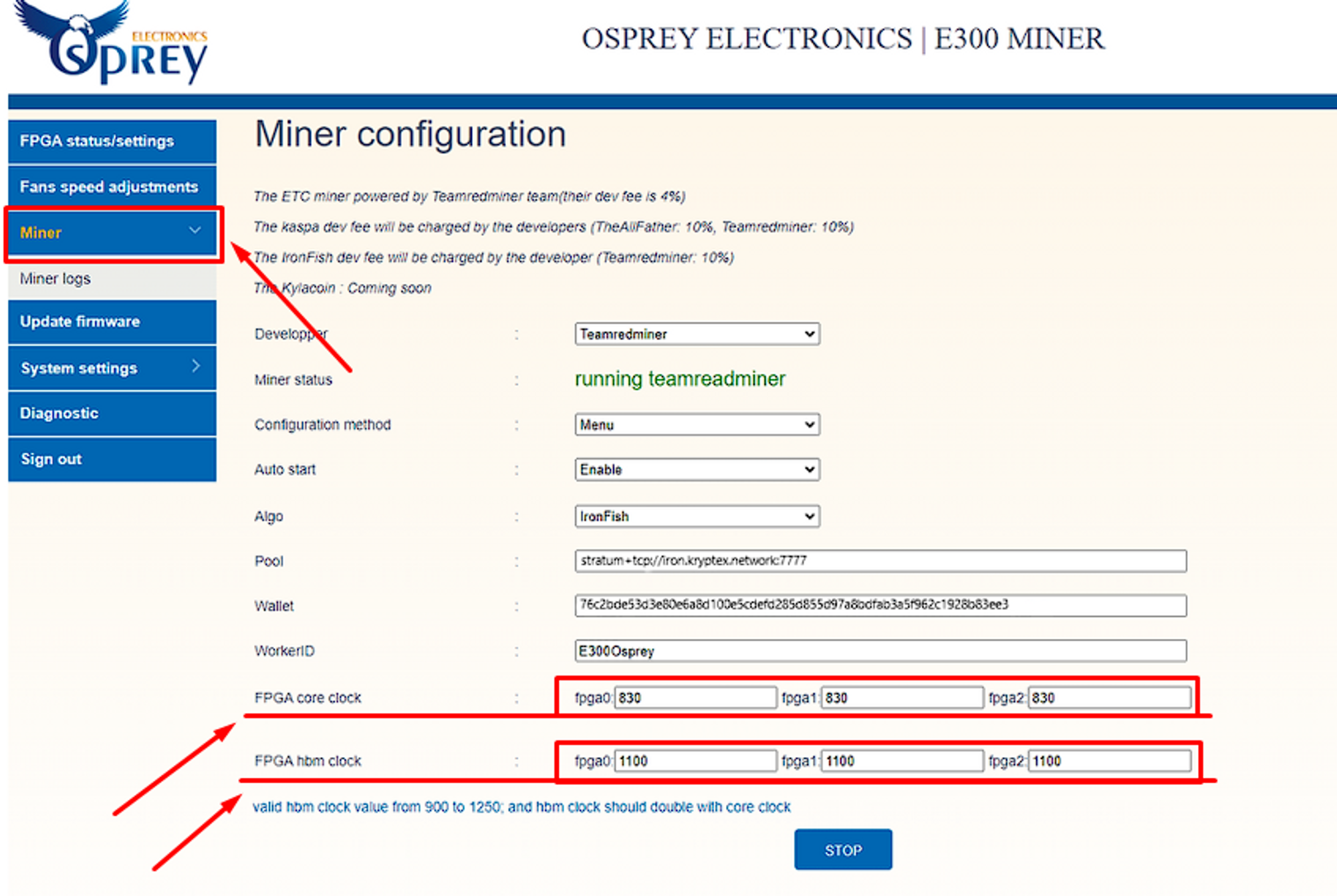
Osprey E100, E300 Firmware Update
If necessary, you can update or change the firmware yourself, for this:
- Go to the manufacturer's Discord and download the required firmware.
- Open the page for updating “Update firmware”, select the downloaded update.
- Update and reboot your FPGA.
You can enable auto update of your FPGA — tick the "Enable auto update firmware" box.
